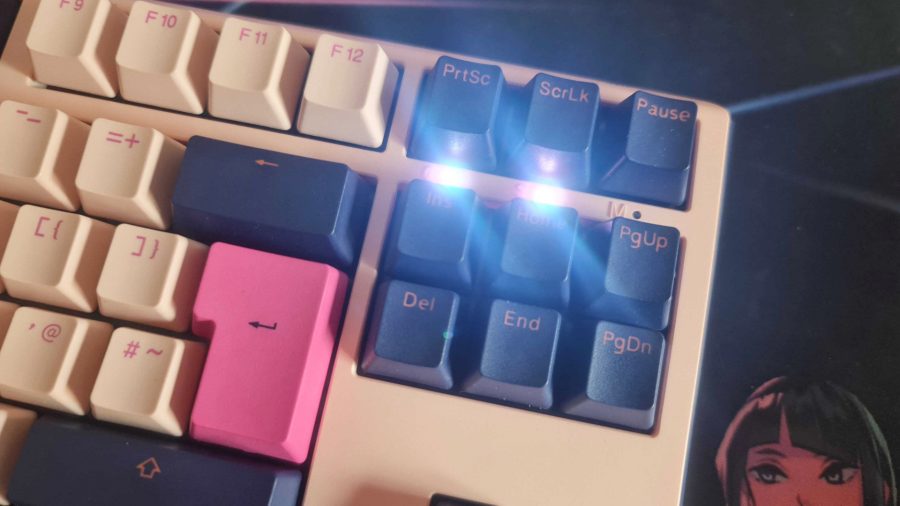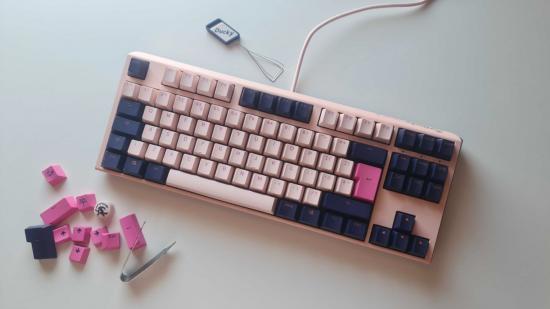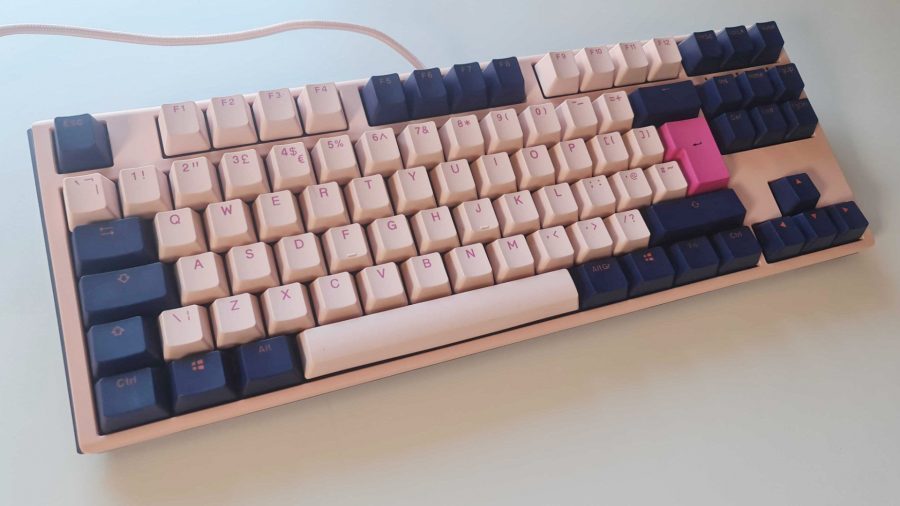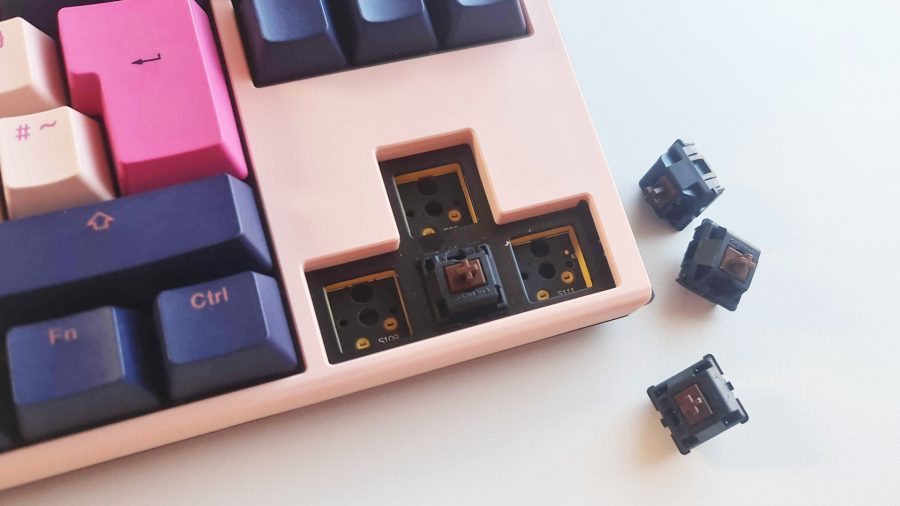Our Verdict
It makes marked improvements over its predecessor and the Fuji edition is a treat for the eyes, but Ducky desperately needs to give its gaming keyboards some software.
You’d think it’d be difficult for a dedicated gaming keyboard maker like Ducky to stand out against behemoths like Razer, Corsair, and Logitech, but here we are, and the Ducky One 3 is a sight to behold – especially the Fuji TKL edition. It’s built like a brick, but its colour palette looks as elegant as the cherry blossoms in spring, and it offers a whole lot of value in its price tag.
The best thing about the Ducky One 3 is its customisability. You can choose from a bunch of different sizes, including the full whack, TKL without the numpad, SF (65%), and a Mini 60% model that forgoes the arrow keys. There’s the mechanical switches underneath, which range from Cherry MX Speed Silver to MX Silent. And there’s a ton of eye-catching colourways to suit your setup.
You could stick with your bog standard backlit black if you fancy, but if you don’t mind sacrificing the RGB LEDs, there are a good few designs on offer. Daybreak is a wonderful deep blue with grey and yellow tones; Matcha blends a pastel green with a cream backdrop; and the model we’re testing today, Fuji combines pinks with navy blue. Sure, the lack of lights might turn some away and it’s nice to have the option, but I’d argue anything more would be overkill.
While the HyperX Alloy Origins 60 and Corsair K65 RGB make a conscious effort to chuck in a custom spacebar to thread your setup together, the attention to detail on the Ducky One 3 Fuji TKL is next-level. The legend on each doubleshot PBT keycap compliments the colour of the key itself, the two-tone body with an extra wide bezel adds a neo-retro flare, and the default arrangement is beyond satisfying to look at.
| Pros | Cons |
| Beautiful colourway | LED indicators are distractingly bright |
| Smooth typing experience | No software |
| Sturdy build | No RGB backlighting |
| Themed doubleshot PBT keycaps | DIP switch and some shortcuts don’t work |
If you’re not happy with the colour layout straight out of the box, there’s an extra set of hot pink keys, a navy enter key, and a custom rounded keycap with the Ducky logo so you can truly make this your own. Usually, you only get these kind of quality keycaps when you opt for a custom set or go artisan, which can easily push the price of your gaming keyboard into eye-watering territory.
Every inch of this keyboard is themed to truly complete the look, including the blue underbelly, the pink USB-C to USB-A wire you can feed through the left, right, or centre using the cable routing system, and the two-step pink feet that can adjust between different heights. I prefer a steep incline and almost always default to the highest I can prop a keyboard up, but it’s nice to have the option for a shallower lift.
For a brief moment after unboxing, I actually mistook the Ducky One 3 TKL for its full sized cousin, partly because I’d grown accustomed to the petite Mountain Everest 60, but mainly because it feels like a bit of a chonk. It’s actually more than 4% lighter than the Ducky One 2 TKL series at 908g, but it feels weighty and its protruding bezels give the illusion that it’s larger than it is. It might not be as hefty as its predecessor, but it won’t slide around your gaming desk easily, thanks to strong rubberised feet that keep it in place.
 Image credit: PCGamesN – and yes, this really is unedited
Image credit: PCGamesN – and yes, this really is unedited
My biggest gripe about the design is the LED indicators that signpost when your caps lock and scroll lock keys are active. You might think I’m exaggerating when I say they’re as bright as the sun, but regardless of hyperbole, using caps lock as my Discord push-to-talk button makes for a big distraction during firefights in Rainbow Six Siege. It’s almost as if the enemy is signalling morse code for me to surrender. I might be ambitious in explaining away my aggressively average K/D with a pair of LEDs, but they certainly rubbed salt in the wound when I’m watching the killcam partially blind.
On one hand, I praise the lack of software making this a truly plug-and-play device without any bloat, but this also means there’s no way to turn these lights off. You simply have to suck it up and get used to it or risk ruining the aesthetic with some tape. Of course, your mileage may vary with different keybinds and it might not bother you as much, but Ducky could prevent it entirely if it just dialled it down a notch.
Without software, you’re also at the mercy of on-board controls to make the most of your keyboard. There’s the return of six different profiles, five of which are customisable, but you’ll have a ton of key combinations to learn in order to shape macros how you want them. Some default shortcuts don’t even work, such as locking the Windows key, whether you’re following the instructions or trying to use the DIP switch on the rear. In fact, the DIP switch was merely decorative for me, which might be a firmware issue. Sadly, the firmware updater wouldn’t play ball, either. Needless to say, it’s about time Ducky unveiled software to make this process easier.
Typing on the Ducky One 3 Fuji TKL is a dream. It’s not just about the Cherry MX Browns that I’m plenty used to from previous models, but the ergonomics, quality of the build, and thoughtful design elements that all make this an ideal work keyboard. The new silicon layer between the plate and PCB and EVA foam base, which Ducky dubs its ‘Quack mechanics’, makes it feel like you’re clicking a cloud with no unwanted sound, just satisfying clacks. The only exception is the space bar, which is significantly thunkier than the rest of the keys and could be bothersome to heavy typists or those around you in an office.
Another upgrade over the Ducky One 2 series is the inclusion of hot swappable switches. It might seem a little fiddly at first, but Ducky arms you with everything you need and it certainly gets easier the most you do it – provided you don’t lose the keycap and switch pullers. It’s far from the first to let you change between different switches, but it’s a welcome overhaul that’ll make the Ducky One 3 TKL last far longer than most keyboards on the market. Break a stem? Temporarily replace it with a switch from a key you don’t use all that much while you wait for new switches to arrive, which is far cheaper than forking out for an entire new board.
The Ducky One 3 TKL Fuji TKL packs a big punch for its $122 / £130 price tag. While its lack of software means it isn’t as functional as the likes of the SteelSeries Apex 7 TKL, the cost is offset by the superb themed PBT keycaps that’d otherwise take another big bite out of your bank account and hot-swappable switches that often come at an added premium. There are minor design flaws that drag it down and it could be more intuitive in its approach to profiles and shortcuts, but when something looks this good for just over $100, it’s hard to argue that it’s a bargain.


